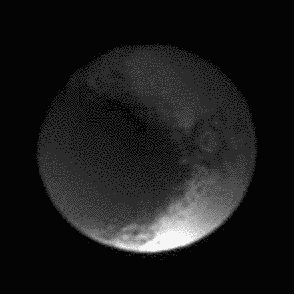Emily Lakdawalla • Feb 21, 2007
A new way to darken Iapetus
Iapetus is one of the many fascinating bodies in the Saturn system. It's Saturn's third largest moon (smaller only than Titan and Rhea) and it orbits way out from the planet, far beyond all the other icy moons, on an orbit lilted 15 degrees from the ring plane. Half of its surface has been darkened by some still-unknown process. Because of Iapetus' distance from Saturn and its orbital inclination, it will take a very special effort by Cassini to set up one orbital loop that will swing it close by the moon, a much-anticipated event that will occur on September 10 of this year. So, for the most part, Cassini's observations of Iapetus are from a distance of a million kilometers or more.
Cassini seems to take advantage of every opportunity, no matter how distant from Iapetus, to take a full-color set of images, studying the spectral properties of that strangely dark surface. So I'm used to seeing pictures like this one crop up on the Cassini raw images website:
We see Iapetus in a gibbous phase. It is illuminated by the Sun from the left, so the right side of its globe is dark because it's night there. The left side of the globe is dark because of that strange dark coating that covers Iapetus' surface. Those are the usual two ways you see a darkening of Iapetus' surface. Now, check out this photo, which was taken last week:
At first glance, this might look like Iapetus is in a crescent phase, being lit from the lower right. But the shape of the "terminator" -- the bright-dark boundary separating the dayside and nightside of a globe -- is wrong, and you don't see stark shadows along its edge that you ordinarily get from oblique, twilight lighting conditions; compare it to the first image I posted. Furthermore, you can see that there are now three different shades on Iapetus: brightest at lower right, medium-dark on upper right, and dark-dark at the left. Have you figured it out yet? It's an eclipse! Iapetus' orbit has taken it into the edge of Saturn's shadow. The shadow is cast across the dark terrain on the left of the globe and some of the bright terrain on the top right. You can confirm this by going to JPL's Solar System Simulator and asking to look at the Sun as seen from Iapetus on February 14. By playing with this, plugging in different times of day, I found that on that day, the shadow of the rings should also have been cast across Iapetus...
There were a whole series of images of Iapetus taken on February 14. I've animated them below. It begins with the globe being mostly in eclipse, and ends with it being completely out of eclipse. After looking at this animation, I realized that the sequence might be even cooler than I had first thought. I'm not sure about the geometry, and I don't know how much time is passing from frame to frame. But I think, from the way that the shadow flickers, we might actually seeing the shadows of the rings crossing Iapetus. Way cool!

The Time is Now.
As a Planetary Defender, you’re part of our mission to decrease the risk of Earth being hit by an asteroid or comet.
Donate Today

 Explore Worlds
Explore Worlds Find Life
Find Life Defend Earth
Defend Earth

